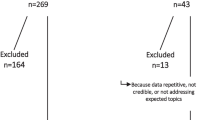Abstract
Purpose : To investigate whether the consecutive embryo transfer of day 3 embryos and of blastocyst protects against failure to reach embryo transfer and provides additional pregnancies.
Methods : An embryo transfer was performed on day 3 following which all remaining embryos were cultured to the blastocyst stage for a possible second transfer.
Results : One hundred and forty-two patients were selected for extended culture. Thirty-two of these patients did not develop blastocysts in culture, however, there were 12 pregnancies achieved in this group.
Conclusions : The consecutive transfer of day 3 embryos and blastocysts can prevent the total loss of a cycle when embryos fail to develop to the blastocyst stage in culture and thereby provide additional pregnancies.
Similar content being viewed by others
REFERENCES
Gardner DK, Vella P, Lane M, Wagley L, Schlenker T, Schoolcraft WB: Culture and transfer of human blastocysts increases implantation rates and reduces the need for multiple embryo transfers. Fertil Steril 1998;69:84–88
Alper MM, Brinsden P, Fischer R, Wikland M: To blastocyst or not to blastocyst? That is the question. Hum Reprod 2001;16(4):617–619
Scholtes MCW, Zeilmaker GH: Blastocyst transfer in day-5 embryo transfer depends primarily on the number of oocytes retrieved and not on age. Fertil Steril 1998;69:78–83
Huisman GJ, Fauser BC, Eijkemans MJ, Pieters MH: Implantation rates after in vitro fertilization and transfer of a maximum of two embryos that have undergone three to five days of culture. Fertil Steril 2000;73(1):117–122
Ashkenazi J, Yoeli R, Orvieto R, Shalev J, Ben-Rafael Z, Bar-Hava I: Double (consecutive) transfer of early embryos and blastocysts: Aims and results. Fertil Steril 2000;74(5): 936–940
Dean NL, Phillips SJ, Buckett WM, Biljan MM, Tan SL: Impact of reducing the number of embryos transferred from three to two in women under the age of 35 who produced three or more high quality embryos. Fertil Steril 2000;74:820–823
Biljan MM, Dean N, Hemmings R, Bissonnette F, Tan SL: Prospective randomized study of the effect of two flushing media on oocyte collection and fertilization rates after in vitro fertilization. Fertil Steril 1997;68(6):1132–1134
Coskun S, Hollanders J, Al-Hassan S, Al-Sufyan H, Al-Mayman H, Jaroudi K: Day 5 versus day 3 embryo transfer: A controlled randomized trial. Hum Reprod 2000;15(9):1947–1952
Scott L, Alvero R, Leondires M, Miller B: The morphology of human pronuclear embryos is positively related to blastocyst development and implantation. Hum Reprod 2000;15(11):2394–2403
Gardner DK, Lane M, Stevens J, Schoolcraft WB: Noninvasive assessment of human embryo nutrient consumption as a measure of developmental potential. Fertil Steril 2001;76(6):1175–1180
Author information
Authors and Affiliations
Rights and permissions
About this article
Cite this article
Phillips, S.J., Dean, N.L., Buckett, W.M. et al. Consecutive Transfer of Day 3 Embryos and of Day 5–6 Blastocysts Increases Overall Pregnancy Rates Associated with Blastocyst Culture. J Assist Reprod Genet 20, 461–464 (2003). https://doi.org/10.1023/B:JARG.0000006708.26464.23
Issue Date:
DOI: https://doi.org/10.1023/B:JARG.0000006708.26464.23




